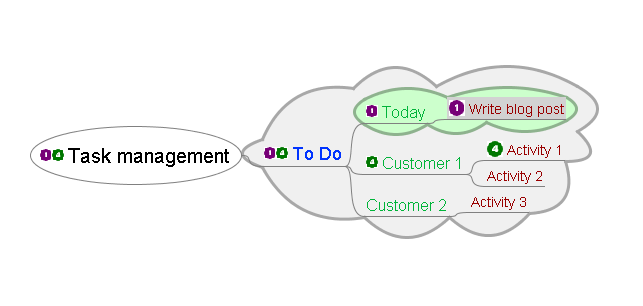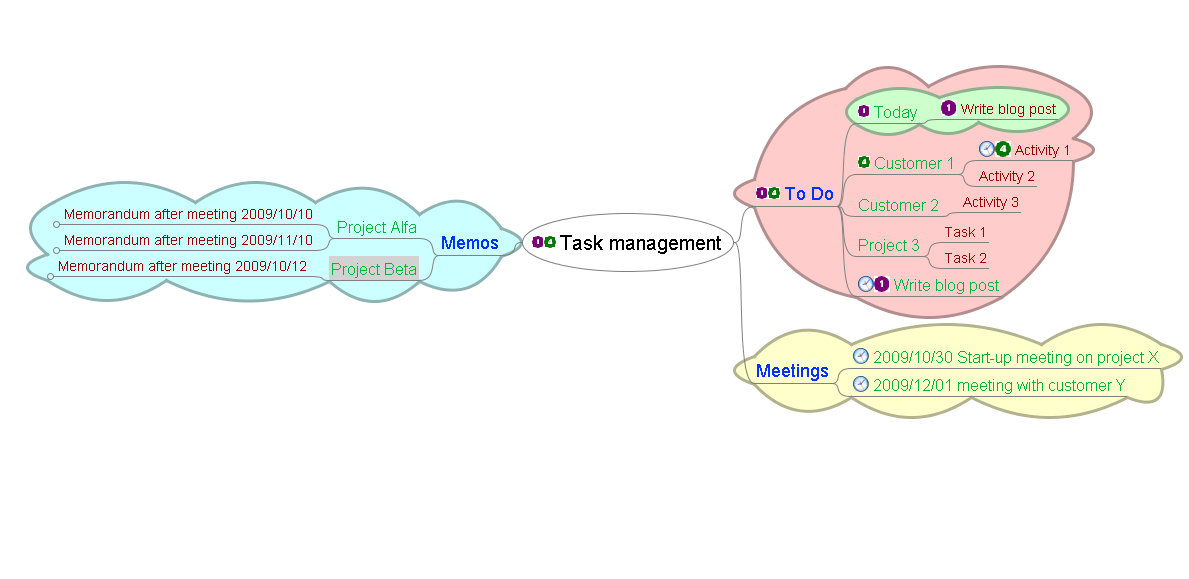Apr 02 2011
(Italiano) Finalmente mind mapping su iPad
Sorry, this entry is only available in Italiano.
Apr 02 2011
Sorry, this entry is only available in Italiano.
Jun 06 2009

In the previous My "ToDo" Map post I tried to explain how I use Freemind in order to keep things to do organized.
After a lot of time I'm using a mind map to keep track of tasks, memos, meetings, and so on, I realized that my map evolved to a new fashion. Step by step, I moved the nodes of the map and my map turned into a more mature shape.
If you like, you can download a "ToDo" Map for freemind as an example of the structure I will write about in this post.
With time I realized that the "now on air", "today" and "by day" grouping (see my previous post) is ineffective mainly due to these reasons:
The last point is the main cause to the evolution of my map. From a theoretical point of view I would have had the capability of defining things to do in the future with high precision, but real life is far from theory. The typical working day is full of accidents, urgencies, unpredictable events that make strict plans unusable, so any guess to strictly define future task failed.
Due to the limits described I defined the "evolving map". The "evolving map" (compared to the more static original map) is a map capable of transforming its structure over time in order to keep strong relationship with the real load of tasks. This type of map is well suited for frequent and fast redesign of plannings and facilitates the managements of urgency and low priority activities.
In order to transform my original "static" map the new "evolving map" I merged all the future tasks under a single "to do" node and I catalogued them in terms of priority and deadline (as deadline I mean the reasonable date and time in which one task should have placed under production to be completed in time) . The nodes "now on air" and "today" merged into a single node containing all the things I planned to do in the current day picked from the more general "to do" node.
Al the tasks are mixed together under the general "to do" node. The differentiating attributes are priority and deadline. Freemind helps a lot in this differentiation with "priority icons" (numbered from 1 to 7 in Freemind) and timers (only present in the full version of Freemind ) capable of alert when a the timer (placed at node level) reset.

Now let's see how to manage the main activities required in an usual task management:
In order to add a new task I have only to evaluate two things: when I need the task to be completed and how important is compared to all the other tasks I have to do. Then I placed a new node under the node "ToDo", I set a timer to a reasonable date before the due date and place a priority icon indicating the priority of the task. In this meaning priority is a rate for "importance" of the task.
Note about deadline: for unimportant or long term tasks, is usual not to have a strong deadline; so I place the timer at the date in which is thought a priority escalation. Two things can happen: in case of light load maybe I can complete the task before the alarm, in case of heavy load maybe the low priority task remains on queue for long so the alarm reminds the priority escalation. This ensure the task will be done in a reasonable time.
Note about priority/deadline: The use of priority and deadlines enables to the famous "important/urgent" time management model. In this model an effective time management is done rating the things to do in terms on Important/unimportant and urgent/unurgent tasks. Importance defines how much attention I have to place into the task; urgency defines how fast I have to take into account the task.
In this time management model:
The mind map can model this scenario simply managing urgency by timers and importance by priority. This affects how one retrieve things to do.
I usually work at my notebook with my ToDo map open in background. Every morning and sometimes during the day I look at my map and I see what I have to do. Two things can happen:
Purging done things is the most beautiful operation because this means I have less things to do.
Usually this operation is simply a node deletion, when I need an historical view of done tasks I put these nodes under a specific node called "Done". If I preserve node I remove timer and priority icon.
Rearranging schedule is the most strategical operation involved in task management. Freemind (and in general mind maps) helps a lot in rescheduling because is really fast and intuitive in moving nodes into the map.
Rescheduling is necessary in three specific moments:
In all these situations I have to stop, look at the snapshot of the map and decide how to move hierarchically, in time and in priority the nodes. This operation makes me think to an "evolving" map, because if you could take a picture of the map at regular intervals you could see that the map changes in shape like a living being, expanding and contracting rhythmically as to the beating of the heart.
In the evolution of my primitive map, some other features took a new place: meetings and memos.
Meetings or tasks with precise collocation in time can be, of course, added to the set of things to do with a specific timer set in order to remind when the meeting happen, although meetings have unique characteristics that normal tasks don't have. First meetings haven't priority (once decided to attend to the meeting), then meeting are mono-task activities in the sense that cannot be done in parallel with other tasks, finally meetings cannot be done neither before nor after the planned date, in other words meetings occupy a precise window of time on the calendar.
Due to this considerations I found effective to place meetings together under a specific node and use timer as a rimender. In the text of the node I write the meeting date and time and I place the timer some days before the actual meeting date.
Memos are reminders, notes, memorandums took during meetings and phone calls. These type of information are not well suited to be placed under the ToDo node, so I have collect this information under a specific node called "Memos". Maybe I never delete these nodes, usually when the information stored is part of agreements or represent fundamental aspects of my activities.
In the very specific case in which memos are strictly related to a task, and if the lifetime of the memo is tied up with the lifetime of the task, I put the memo immediately under the node of the task placing neither priority nor timer.

I think that the "by day" model I proposed in my previous post is still useful in environments in which the prediction of tasks fits well the real execution schedule, when unforeseen tasks are absent or infrequent, in short when preventive planning is effective. In these type of environments the "by day" model has the merit of highlighting the sequence of tasks and set a strict step by step schedule to be followed.
If you like, you can download a "ToDo" Map for freemind as an example of the structure discussed in this post.
Jan 04 2009
I recently discovered XMind, a mind mapping software, formerly commercial and now branched into two versions: Open Source (published on sourceforge) and Professional (commercial).
I tried both the two versions of this software, however I'm interested in understanding if the Open Source version can actually replace Freemind, the mind mapping software I'm using in my everyday life.
In this post I write about my really first impressions about XMind. I don't touch deeply every functionality and every aspect involved in this project (see the website for a complete description of the software and a comparison matrix for the two versions), in this post I'm only highlighting the features I consider necessary in the choice of a good mind mapping solution.
At the first use of XMind I was immediately impressed about the GUI. The GUI is really modern and nice, nodes are animated, colors are well chosen, elements in the GUI react really fast at the user input and the node dragging is really smooth so the user experience is really intense and pleasant.
I liked a lot the hi-res markers (icons) useful to remember and highlight nodes meaning, and the map styles (structure) one can apply to the map: fishbone, map, org char, spreadsheet, this can make the map apparence different from the classical "tree view" form.
I also appreciate the sheets, making the application a good box in which effectively opening more than one map and clearly see which map is the current and which are in background.
Unfortunately I didn't find a way to propagate markers hierarchically from a node up to the root. I use this feature in freemind and I consider this functionality really useful in order to immediately identify important area of the map.
Of course, XMind provide also all the main features needed in a mind mapping tool, like:
This functionalities are deeply integrate with the advanced GUI, so the resulting sight is really impressive.
In the PRO version there some other interesting features, enabling a more professional use of this tool, like:
Around XMind there is also a nice and good looking website that is the base for an active community sharing mind maps. I don't evaluate aspects related to sharing maps because at the moment I'm not interested and sensible to this topics. In any case I was impressed by the clear and good looking website and the excellent integration between XMind pc client and the web community.
In a mind mapping tools I best appreciate features related to "project management" and "getting things done" (see my previous posts in the "mind mapping" section), unfortunately these features are only provided by the professional (non free) version. This is the main reason because don't plan to switch to XMind now, even if XMind has outstanding functionality in terms of usability, look and feel.
I'm interesting about the road of the OS version compared to the PRO version, in the past I appreciated similar approaches, I'm thinking, for example, to the Interbase/Firebird initiative started by Borland.
IMHO the OS version is an excellent starting point, it isn't common that the OS community can gather a so rich gift, I hope that now the OS community will notice this product and concur in short to the development of the product (at the date of this post the OS project on sourceforge counts only one developer) in order to ensure long and productive life even to the OS version of XMind.
I will follow the Xmind project with great interest.